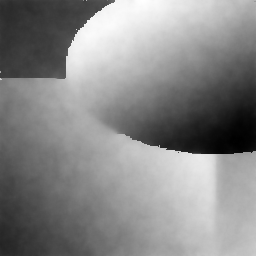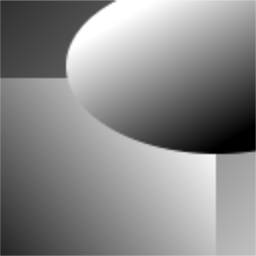Computes a piecewise smooth approximation of a grey-level or color image, by optimizing the Ambrosio-Tortorelli functional (with u a 0-form and v a 1-form).
- Author(s) of this documentation:\n Marion Foare, Jacques-Olivier Lachaud
Usage: at-u0-v1 -i [input.pgm]
(for grey-level image restoration)
Usage: at-u0-v1 -i [input.ppm]
(for color image restoration)
The Ambrosio-Tortorelli functional is a classical relaxation of the Mumford-Shah functional.
Given an input grayscale image, defined in an open bounded domain \( \Omega \), we represent its gray levels by a function \( g \in L^{\infty}(\Omega) \). In the Ambrosio-Tortorelli functional [1], one wants to find a function \( u \in SBV(\Omega) \) which is a smooth approximation of the input image \( g \). The Ambrosio-Tortorelli functional [1] is defined by
\[ \displaystyle AT_{\varepsilon}(u,v) = \int_\Omega \alpha |u-g|^2 + v^2 |\nabla u|^2 + \lambda \varepsilon |\nabla v|^2 + \frac{\lambda}{4 \varepsilon} |1-v|^2 dx, \]
for functions \( u,v \in W^{1,2}(\Omega)\) with \( 0 \leq v \leq 1 \).
In AT functional, function \( v \) is a smooth approximation of the set of discontinuities, and takes value close to 0 in this set, while being close to 1 outside discontinuities. A remarkable property of this functional is that it \( \Gamma \)-converges to (a relaxation of) MS functional as \( \varepsilon \) tends to 0 (see [1]). The intuition is that a large \( \varepsilon \) induces a solution with a fuzzy set of discontinuities, which is then progressively narrowed to the crisp 1-dimensional set of discontinuites as \( \varepsilon \) goes to 0.
We discretize AT with discrete calculus and define \( u \) and \( g \) on the vertices and \( v \) on the edges. We denote this formulation AT10. Gray levels are seen as point mass on the center of pixels, so that functions \( u \) and \( g \) are both 0-forms, while \( v \) is a dual 1-form in between \( u \). It follows:
\[ \displaystyle AT10(u,v) = \Sigma_{i=1}^n \alpha \langle u_i - g_i , u_i - g_i \rangle_0 + \langle v , \mathbf{d_0} u_i \rangle_1 \langle v , \mathbf{d_0} u_i \rangle_1 \\ + \lambda \varepsilon \langle (\mathbf{d_1} + \bar{\mathbf{\star}} \bar{\mathbf{d_1}} \mathbf{\star}) v , (\mathbf{d_1} + \bar{\mathbf{\star}} \bar{\mathbf{d_1}} \mathbf{\star}) v \rangle_1 + \frac{\lambda}{4\varepsilon} \langle 1 - v , 1 - v \rangle_1. \]
For more details, see Image restoration and inpainting with Ambrosio-Tortorelli functional
Allowed options are:
example:
| Input image g | Reconstructed image u | Perfect image |

Input image (noise = 0.4) | 
AT01 alpha=0.05 lambda=0.005 | 
Perfect image |
| SNR of g = 21.9183 | SNR of u = 34.4426 | Perfect image |
- Note
- Other restoration examples, parameter analysis, and image inpainting examples may be found in Image restoration and inpainting with Ambrosio-Tortorelli functional.
[2] Marion Foare, Jacques-Olivier Lachaud, and Hugues Talbot. "Image restoration and segmentation using the Ambrosio-Tortorelli functional and discrete calculus." In Proceedings of the IAPR International Conference on Pattern Recognition (ICPR2016), Cancun, Mexico, 2016.
[3] Marion Foare, Jacques-Olivier Lachaud, and Hugues Talbot. "Numerical implementation of the Ambrosio-Tortorelli functional using discrete calculus and application to image restoration and inpainting." In Proceedings of 1st Workshop on Reproducible Research In Pattern Recognition (RRPR 2016), Springer LNCS. To appear.
[4] Matteo Focardi. "On the variational approximation of free- discontinuity problems in the vectorial case." Mathematical Models and Methods in Applied Sciences 11.04 (2001): 663-684.
 1.9.1
1.9.1